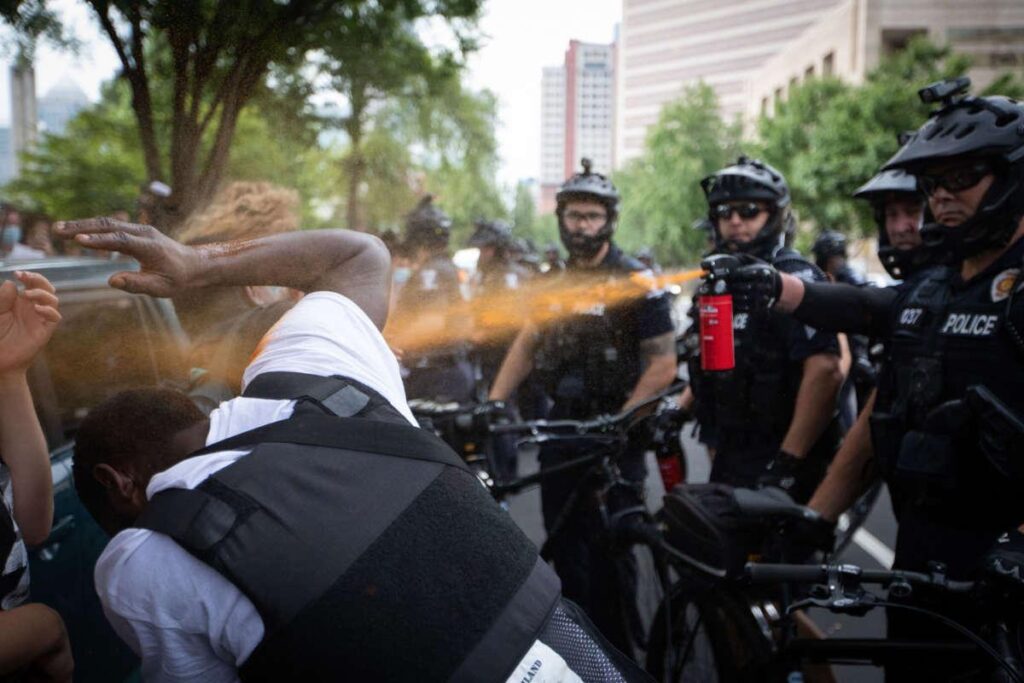Table of Contents
- Courtroom Battles Spotlight Legal Boundaries of Pepper Spray in Demonstrations
- Analyzing the Health and Safety Implications for Protesters and Law Enforcement
- Judicial Responses Shape Future Guidelines on Non-Lethal Crowd Control
- Policy Recommendations for Balancing Security and Civil Liberties in Protest Management
- Concluding Remarks
Courtroom Battles Spotlight Legal Boundaries of Pepper Spray in Demonstrations
Recent court cases have ignited fierce debate over the appropriate conditions under which law enforcement may deploy pepper spray during public demonstrations. Judges are being pressed to balance the state’s interest in maintaining order against individuals’ constitutional rights to peaceful assembly and expression. In several instances, legal scrutiny has centered on whether the use of chemical irritants constituted excessive force or a necessary measure in the face of escalating tensions.
Key legal considerations include:
- Whether police issued clear warnings prior to deploying pepper spray
- The proportionality of force relative to the threat posed by demonstrators
- Documentation of injuries and medical consequences stemming from exposure
- Consistency with established protocols and regulatory guidelines
As courtroom battles unfold, these factors have emerged as pivotal in determining both liability and the boundaries of lawful crowd control. Legal experts anticipate that forthcoming rulings will further define the permissible scope of pepper spray use, potentially influencing police training and public policy nationwide.
Analyzing the Health and Safety Implications for Protesters and Law Enforcement
Health risks for protesters: Exposure to pepper spray, a common riot control agent, can result in immediate and severe physical reactions among demonstrators, including intense eye irritation, respiratory distress, and skin burns. Individuals with pre-existing conditions, such as asthma or cardiovascular disease, face heightened dangers, potentially leading to long-term health complications. Medical reports also highlight cases of chemical-induced panic attacks and exacerbation of chronic illnesses, raising concerns about the proportionality and safety of its deployment in crowd management.
Implications for law enforcement personnel: Officers applying pepper spray are not immune to secondary exposure risks. Contamination from wind or close-range use can cause accidental self-exposure, leading to compromised operational capacity. Additionally, ongoing disputes question the adequacy of training protocols and availability of protective equipment, emphasizing the need for stringent safety measures to mitigate health hazards. Key safety considerations include:
- Comprehensive use-of-force guidelines aligned with health risk assessments
- Proper protective gear and decontamination procedures
- Regular health surveillance and reporting protocols for exposed personnel
Judicial Responses Shape Future Guidelines on Non-Lethal Crowd Control
The judiciary has become a pivotal arena where the boundaries of acceptable non-lethal crowd control methods are being rigorously examined. Recent court rulings spotlight the tension between law enforcement’s operational discretion and civil rights protections, particularly in the contentious deployment of pepper spray during large-scale demonstrations. These decisions are gradually informing a more nuanced legal framework that emphasizes restraint, proportionality, and accountability. Judges have underscored the necessity for clear guidelines on when and how such measures can be employed, balancing public safety with constitutional freedoms.
Key judicial opinions emphasize several crucial factors shaping future protocols:
- Strict adherence to necessity and minimal force to prevent unnecessary escalation.
- Detailed reporting and transparency requirements following any use of chemical agents.
- Independent oversight mechanisms to investigate complaints and misuse allegations.
- Enhanced training mandates for officers on human rights and crowd psychology.
Policy Recommendations for Balancing Security and Civil Liberties in Protest Management
To navigate the complex intersection of public safety and individual rights, authorities must implement clear guidelines that prioritize both effective protest management and the protection of civil liberties. This requires rigorous training for law enforcement personnel on the appropriate, proportionate use of crowd control tools such as pepper spray. Emphasizing de-escalation techniques and informed discretion can reduce the likelihood of unnecessary force, fostering trust between protesters and police. Moreover, transparency in documenting uses of force and providing accessible channels for grievances will hold agencies accountable and enhance community relations.
Policymakers should also consider multifaceted reforms, including:
- Independent oversight bodies tasked with investigating complaints of excessive force to ensure impartiality.
- Clear restrictions on chemical agents,
- Community engagement initiatives to facilitate dialogue and understanding between law enforcement and protest groups before events occur.
These measures collectively aim to uphold public order while respecting the constitutional rights of demonstrators, ultimately reducing contentious legal battles surrounding the use of force in protest contexts.
Concluding Remarks
As court battles continue to unfold over the use of pepper spray during protests, legal experts emphasize the delicate balance between maintaining public order and safeguarding individuals’ rights to peaceful assembly. These disputes highlight ongoing tensions surrounding law enforcement tactics and civil liberties, signaling that the debate over appropriate crowd control measures is far from settled. Observers and stakeholders alike will be closely monitoring the outcomes of these cases, which may set important precedents for protest policing and accountability in the years to come.Check Our Other Blogs
- StunGun – Your Trusted Source for Stun Guns, Laws, and Self-Defense Tips
- PepperSprayLaws – Your Trusted Resource for Pepper Spray Information
- StunGunLaws – Your Trusted Guide to Stun Gun Legality and Safety




